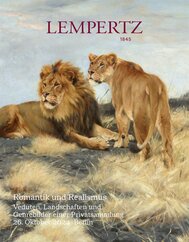Walking is the painter's delight
When a printed ‘World Chronicle’ appeared in Nuremberg on July 12th 1493, large parts of the world were still terra incognita for Europeans. Reports about distant countries and cities often contained adventurous descriptions. It was Hartmann Schedel who brought the distant world closer, illustrated with woodcuts by Michael Wolgemut, Dürer's teacher. This chronicle brought together everything that was known at the time, embedded in a religious framework - from the creation of the world, the Bible and world history, to the then still meagre knowledge of distant geopolitical reality. For a long time, the visual space for the individual remained restricted, such as within the security of protective city walls. Their gates were closed at night, constricting, and whilst only the outside was green and wide, the mountains seemed eerie.
Painting was slow to turn its gaze outwards. In the depiction of biblical scenes, familiar landscapes, medieval towns and cities had to take the place of palm trees in providing the backdrop for the distant, southern world of biblical stories. For centuries, painting remained silent about the appearance of cities, with partial views, at best, handed down and then almost always in connection with depictions of memorable events. The distance drew closer, but slowly. Now no longer just for emperors and diplomats, legions and merchants, but soon also for writers, composers, singers and even painters. However, it was not until the eighteenth century that a wealth of examples in which Dresden, Warsaw, Venice and Rome, Paris or the eerie Vesuvius could be marvelled at from all over Europe. It is the century of the city veduta, and artists in the circle of Canaletto or Guardi provided the travellers of the ‘Grand Tour’ with painted memories. It was not until Classicism and Romanticism that the view of the ancient past - also of the lost cities - was promoted. Italian paintings of ruins, by then considered magnificent, were reminiscent of the past, and Roman heritage with its aqueducts and temple ruins was highly admired. The desire for a new style of architecture - Classicism - had long been philosophically prepared, and many now began to dig in the ruins.
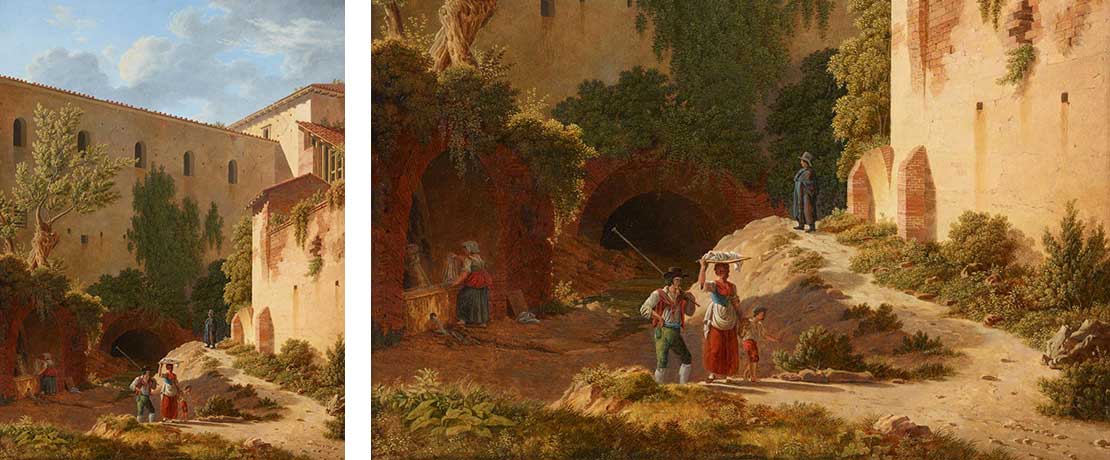
Walking is the painter's delight - Table of contents
Conquerors of the past
First and foremost was the painter Leo von Klenze (1784 - 1864). As an architect, he stands alongside Karl Friedrich Schinkel (1781 - 1841) in the line-up the most important masters in the field. The Glyptothek or the Alte Pinakothek in Munich, the Walhalla near Regensburg and the New Hermitage in St. Petersburg all testify to his ability. He developed his stylistic idiom from his preoccupation with the archaeological legacies of antiquity. As a painter, he documented not only the state of the ‘Cloaca Maxima’ at the time, but with his meticulous reproduction of the ‘Forum Romanum’, for example, he ultimately also prepared the stylistic language that was to be inherent in his architectural works (lots 2 and 3).

Between revolutions
With its austere imperial grandeur, Classicism did not last more than a few decades, with the exception of later Neo-Classicism. The reasons lie deep: even before Klenze built and painted, religion had been in a deep crisis since 1789, and Schinkel's ‘Cathedral over a City’ in 1813 was already a religious swan song. The Battle of the Nations was raging at the time.
Monasteries were abolished and baroque churches demolished. But this rigorousness was not to last long. Klenze's client, the Bavarian King Ludwig I, soon decided to return to the religion of salvation, which was intended to restore order and modesty. The piously painting Nazarenes now entered the art stage and with them the memory of the Middle Ages with its noble cathedral. Last but not least, a newly awakened national consciousness diverted the gaze away from Italy and towards the Gothic, which was now also to express itself in Neo-Gothic style. Interest in the country's own achievements of the past grew and with it their pictorial documentation.
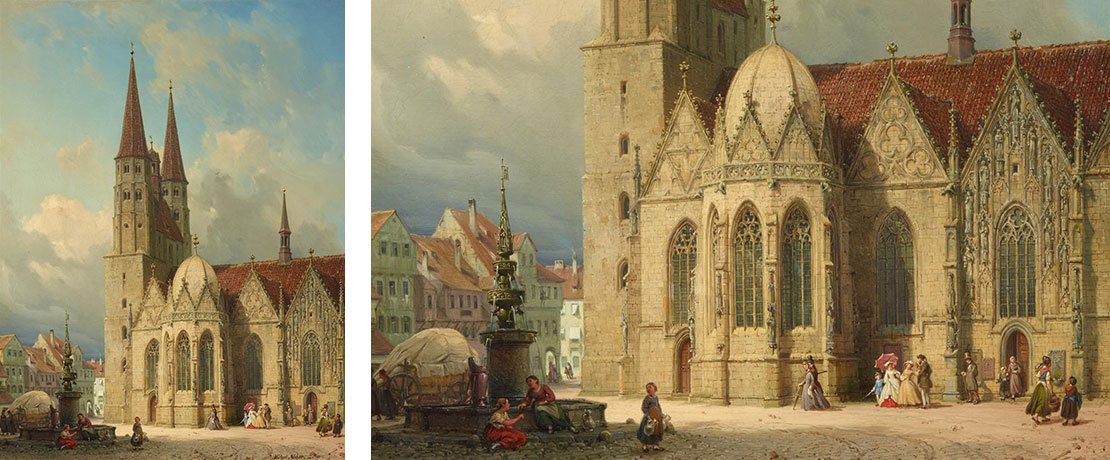
Michael Neher (1798 - 1876) is considered one of the most important painters of the Biedermeier period, one who increasingly devoted himself to the new theme of architectural memory. He painted the Church of Our Lady in Esslingen in 1847, Aachen Cathedral in 1853, and his ‘St. Martin's Church in Brunswick’ (lot 8) was probably also created during this period. Here it becomes clear that he was no longer solely concerned with detail, as Klenze still was. The atmosphere of light, with which Neher here raises the noble, slender church towers against bright clouds into darkness, makes the side chapel appear all the more radiant, whilst the black tracery windows make the interior more mysterious. The subject of the painting takes on a stage-like life of its own. Even the lighting - almost always a warm, golden late glow - has a stage-like effect. The staffage figures, actors in the picture, transport the old building into the cozy Biedermeier era. The same applies to his work ‘St. Leonhard's Church in Frankfurt’ from 1855 (lot 7). The church building stands elevated like a monument, shielded by the church wall, but accompanied by the hustle and bustle of everyday life, in which this guardian of religion hardly seems to take part. The picture emphasises the particular features of that church building: the crouching towers, which still point out from the overall architecture. The entire building seems restrained in the enlightened age. Therein lies the unspoken contemplation of the times, which can only be perceived in the picture.
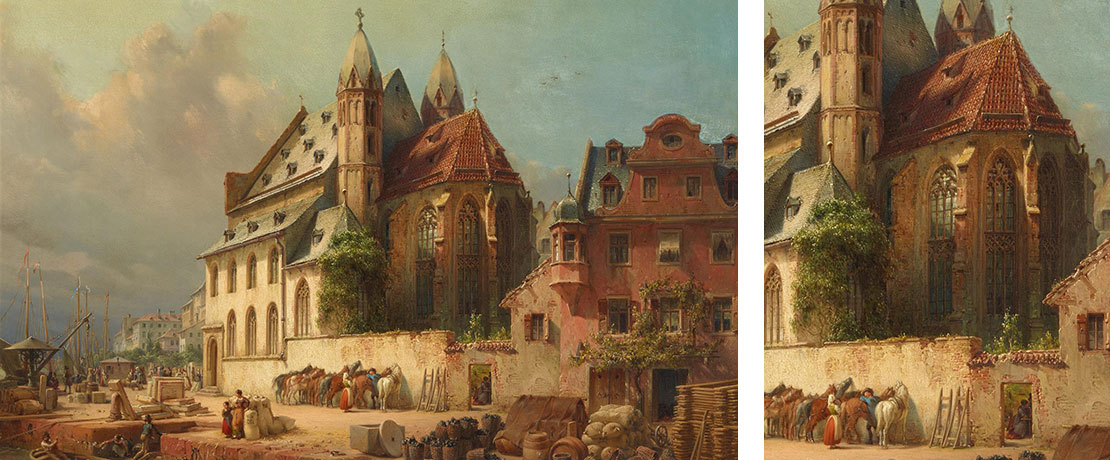
The discovery of proximity
In the meantime, the history of architecture had entered the knowledge of educated circles, and painters also knew that the birthplace of Gothic architecture was in France. Domenico Quaglio II, known as the Younger (1787 - 1837), is regarded in particular as the founder of Munich architectural painting. He was also one of those who was already undertaking extensive travels - through Germany he portrayed cathedrals such as those in Cologne, Regensburg, Strasbourg, Ulm and Freiburg, provided corresponding drawings from the Rhine region, and visited the Netherlands, Italy and France. Here he created a number of preliminary drawings for the ‘Cathedral of Reims’, the old coronation site of the rulers of France. His oil painting (lot 11) also reveals that the painter treated the subject like a monument in distancing dignity: the square in front of it allows us to experience the mighty building at an appropriate distance. A procession of virgins dressed in white piously approaching the deep portal underlines the dignity. The buildings surround the square at an appropriate distance, lending the ancient church and national shrine a dignified frame. The painting must have been much coveted upon its creation, considering the number of times it was repeated.
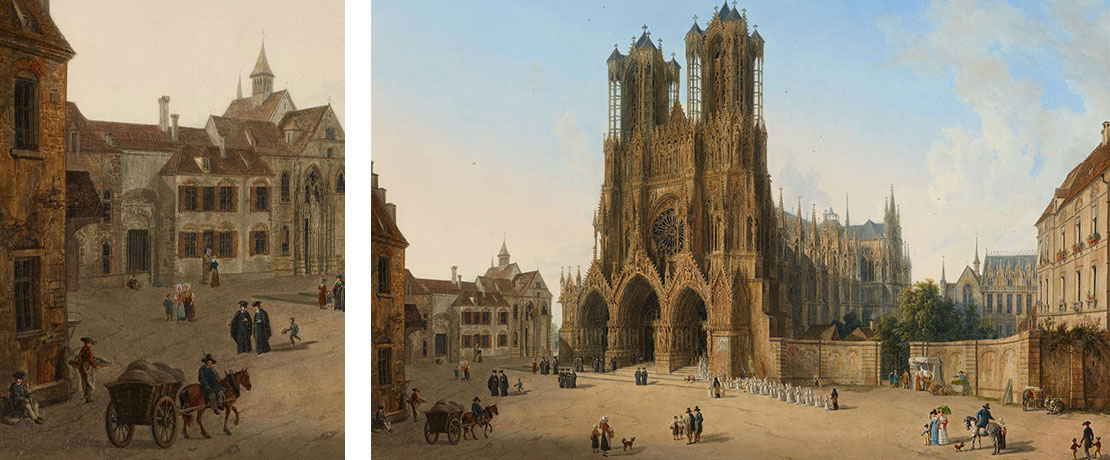
Changing perceptions - Everyday life in the shadow of old buildings
In the history of the cityscape, a change can be observed in the way the main subject is depicted: While the aforementioned painters placed the historical building as the dominant element at the center of the picture, the view together with the surroundings - which grew later – now increasingly appears as an emphatically romantic element. The architecture was to provide a frame for the social life of the respective city. In other words, the activities of the people, the hustle and bustle of the markets, were now the focus of interest.
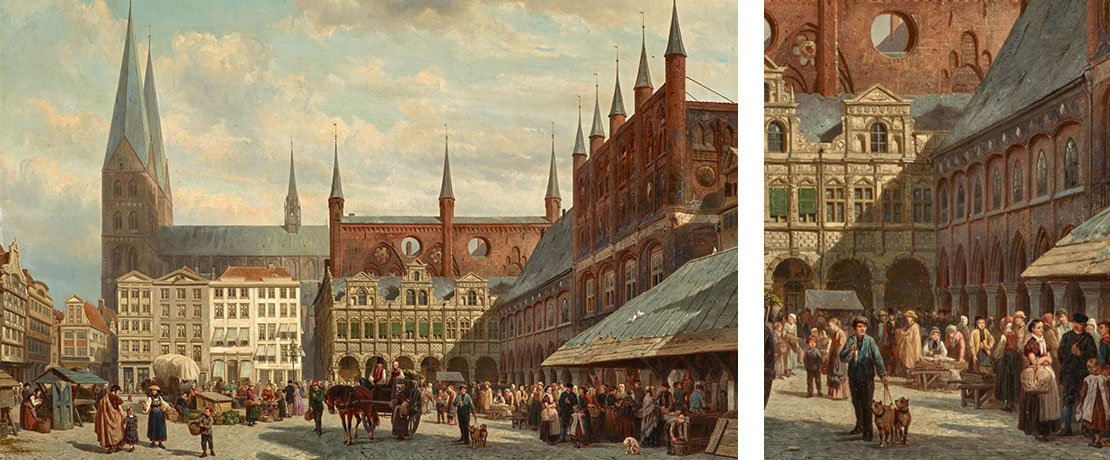
A vivid example of this is a painting by Cornelis Springer (1817 - 1891), in which he portrayed the ‘Market of Lübeck’ (lot 16). In almost all of his paintings, the Dutchman shows a tendency to place the social at the center, with the old buildings as secondary. The contrast to paintings by the aforementioned artists such as Klenze, Neher or Quaglio cannot be seen more clearly. The architecture is now the backdrop. In Springer's ‘St. Martin's Church in Brunswick’ (lot 18), the architecture still speaks clearly, but the buildings are captured from an incidental point of view, they accompany the hustle and bustle of the market. The same applies to his painting ‘Der Grote Markt in Zwolle’, which also only lends the architecture an aspect that enhances everyday life (lot 17). Society is now the focal point of interest - a symptom of the growing bourgeois self-image of the time.
The same applies to the works of Adrianus Eversen (1818 - 1897). He and Springer were almost the same age, although Eversen had studied under the other. Yet the latter's romantic imagination is far more prominent. His painting ‘View of the Wetkerk in Enkhuizen’ reveals how the venerable building has lost its dignity (lot 20). The roofs are full of holes and the plaster has seen better days. The romanticism of decay is also evident in the broken paving in the foreground. Now it is the people at work on which the attention is focused.
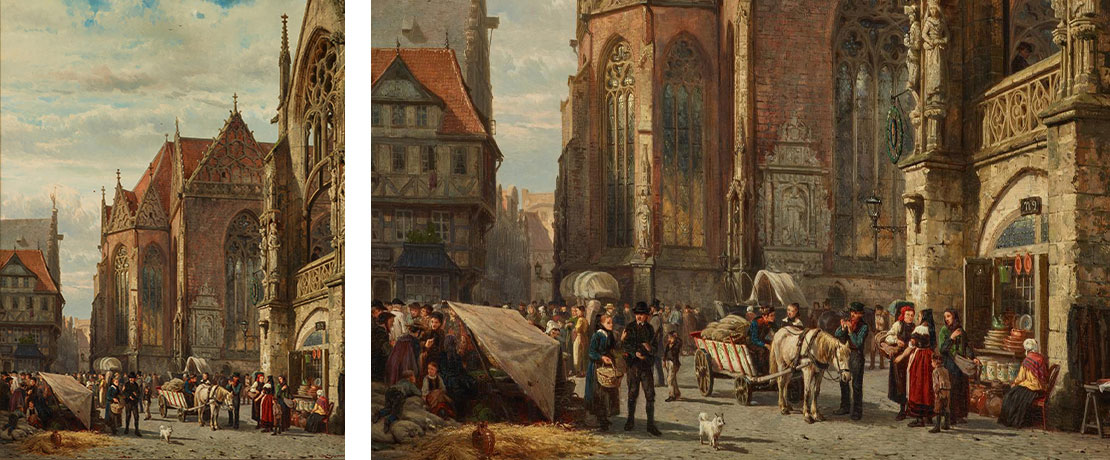
Through city and countryside
The Viennese painter Rudolf von Alt (1812 - 1905) was also a travelling and painting reporter. When his path led him to Franconia, he created the ‘View of Nuremberg’. Here, however, the emphasis on genre and city view is balanced (lot 15), perhaps due to the fact that his father was already working as a veduta painter, accompanied by the young Rudolf on his travels. The focus was naturally on documenting the location or typical city views. His pictures were often created in collaboration with his father and, as a matter of course, his Viennese views included St. Stephen's Cathedral or the Court Museum, but also St. Mark's Square in Venice. His view of Nuremberg from 1864 is actually a depiction of the important city center, with the beautiful fountain in front of the Frauenkirche, one of the most popular motifs of the old imperial city. It is clear from the staffage of people that Alt did not want to suppress his memories of Viennese society, as it cheerfully appears here.
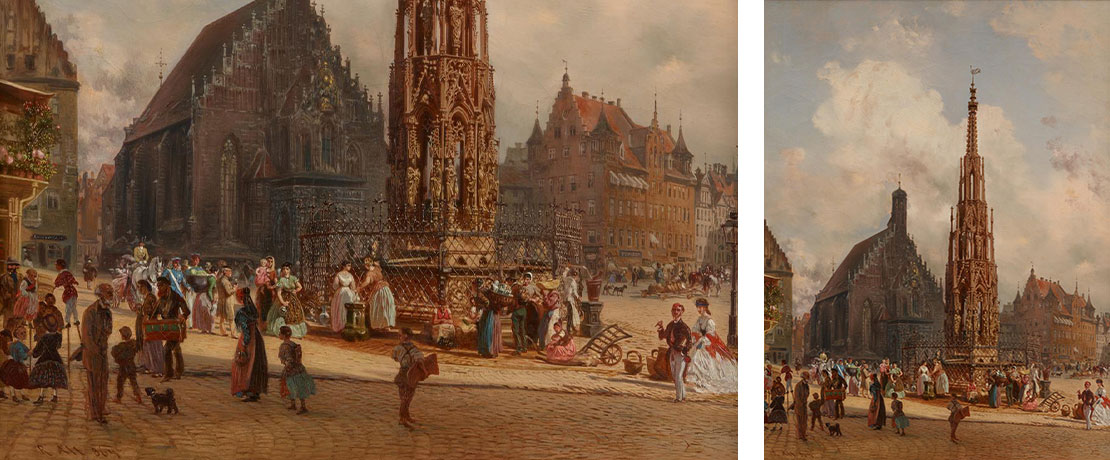
To wander was not only the miller’s delight
A completely different aspect is illustrated by those views in which the rural surroundings of the cities were to have an effect. The cities had largely laid down their walls. Texts from Schubert's ‘Schöne Müllerin’ describe the desire that had grown, to finally celebrate rural freedom and the breaking down of the constraining walls: “I came here a stranger, I depart a stranger…”. The roaming of the young guild men, a newly awakened interest in exploring the distance had become a theme in quite a few works of art. Heinrich Heine set a literary monument to this theme in 1824 with his impressions of his Harz journey.
Barend Cornelis Koekkoek (1803 - 1862), born in Middelburg in the Netherlands to a family of artists, moved to Kleve in 1834. His work clearly shows that he was far more attached to traditional Dutch landscape painting than his German painter colleagues.

Thus his painting ‘The Wartburg near Eisenach’ is initially clearly a landscape in the true sense of the word, but also a contemporary document of a national monument that has since become historically significant (lot 23). The romantic view of this castle shows how much history and landscape could now be seen as one, especially in the context of the patriotic ‘Wartburg Festival’ of 1817.
The Hamburg artist Christian Ernst Morgenstern (1805 - 1867) is regarded as a representative of ‘Painterly Realism’. After moving to Munich in 1836, he became known above all for his Upper Bavarian landscapes. He undertook even more extensive journeys, for example to Russia, Reval and Riga, and travelled to Scandinavia via Copenhagen. For the first time in connection with his work - and comparable paintings by his contemporaries – criticism was later voiced: Around 1920, the art historian Paul F. Schmidt wrote “...but as important as Morgenstern had been for the development of pre-Impressionism around 1830 ... the tendency of the time to theatricality and exaggeration gave… a fatal sting in the emotive...”. However, this is by no means the case for Morgenstern's ‘Landscape with Travellers’ from 1836 (lot 37), as the painting provides a down-to-earth depiction of the times: travellers next to workers in a vineyard. This social idyll is viewed from an elevated vantage point, with a far-reaching view over the landscape and the small town in the valley, which seems sheltered behind its walls, while autumn mist and chimney smoke hover over the roofs. Morgenstern has reconciled work, travel and the Biedermeier bourgeoisie here.
Aesthetic meets emotion
In Morgenstern's works, too, we soon find atmospheres. Evening glow, gathering thunderstorms, cool morning light or moonlit nights. Literature, especially poetry, satisfies the desire for such sensations in abundance. Heine, Eichendorff, Mörike and many others have provided examples, and musicians have composed to them. The mood, of whatever kind, was now also applied to depictions of distant cities and landscapes in paintings. This can be clearly seen in corresponding views of Venice, for example. Whereas in the 18th century such cities were still ‘portrayed’ by means of vedute, soon it was not only the ‘soft picture’ with precisely documented physiognomy that became the subject, but rather the mood of the light or weather.

One example was provided by Friedrich Nerly (1807 - 1878), born in Erfurt. He is best known for his so-called ‘Venice vedute’. But if one takes a closer look: are his paintings actually still “vedute” in the traditional sense, especially in comparison with the views of the earlier Venetians? Were then vedute still necessary? Did not every traveller already know these cities and their prominent buildings? The emotional aspect thus predominates, for example in Nerly's ‘View over the Bacino di San Marco in Venice’ by sunset (lot 38). The depiction hardly brings the city itself nearer, as it appears here literally removed into the distance, as a kind of overall view of the Serenissima. The buildings, domes, the Campanile or the Doge's Palace are already in the shade, and the ship with its high rigging rests compositionally as if on equal footing on the calm, wide canal.
In his ‘Canal Grande’ picture (lot 39), too, the message lies less in the depiction of the palazzi and more in conveying the wintry atmosphere, so unexpected for the south, with the lightly snow-covered roofs and barges. The dome of Santa Maria della Salute stands out only as a winter-grey silhouette against the evening-red horizon. Nerly - who was still able to meet Goethe in Erfurt, and who had changed his actual name from Nehrlich to Nerly –finally settled in Venice in 1835 and was therefore able to witness such a rare wintry atmosphere in the lagoon city.
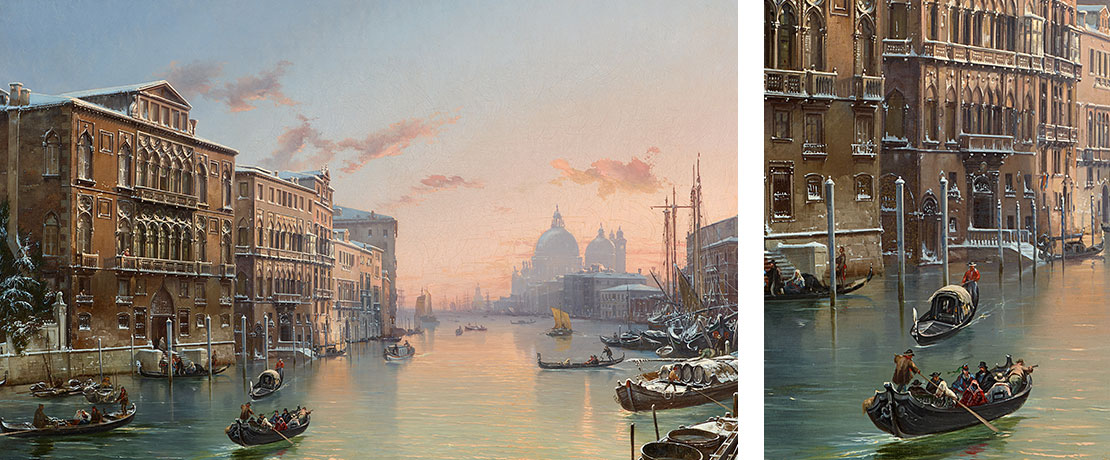
A view into the distance
Venice, Italy and Sicily were the starting point for landscape and city paintings from even further afield. Hermann David Salomon Corrodi (1844 - 1905) was born to a Swiss painter in Frascati. His ‘View across the Sea of Marmara to Constantinople’ is to be the last painting in our discussion (lot 42). His year of death reveals that he was one of those who had already experienced the new century. Even the most distant journeys were now easier and more affordable. An overview of his oeuvre reveals him to be an ‘Orientalist’, at least in terms of the landscape.
City views of Cairo, landscapes on the Nile, oases and camels under palm trees followed his pictures of Sorrento. His view, also, of the city on the Bosporus was not presented in a meticulous veduta manner. As in Nerly's winter painting of Venice shown earlier, a wall of mist hangs in front of the dome of Hagia Sophia, drawing a romantic silhouette of the city. The arched architecture with the cypresses, held in mysterious darkness, also enhances the backdrop effect.
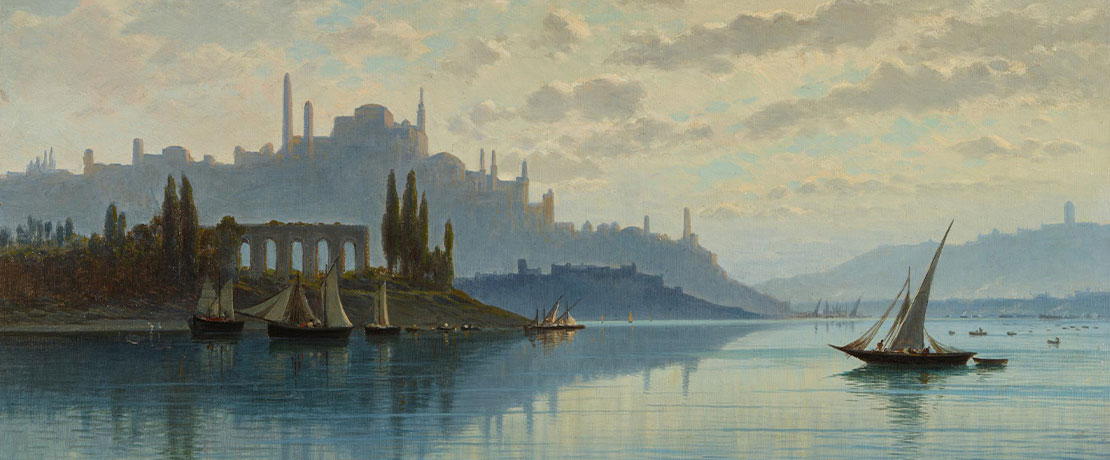
Review
Over the course of the century, the longing for distant lands led to a form of image mediation in which atmosphere became increasingly more important than pure documentation. The urban landscape painting of this 19th century had ultimately reached a level that could be called a high point, or rather an end point, in the sense of naturalism. Seen over time, these developments show how a distance between the object and the viewer, characterised by emotions, slowly emerged with atmospheric painting. Ultimately, such a development could only be continued in a style of painting that we know as Impressionism. Atmosphere as impression. Such ‘impressions’, often misty, as already felt in the last paintings shown, were ultimately the precursors to a style of painting that sought to blur objective reality into a subjective impression. The great Impressionists were ultimately to develop a new brush technique in order to come even closer to this idea. The history of landscape and city painting went through various phases over the course of the 19th century, much like the art of all other genres: Idealisation of the ancient past was followed by romantic transfiguration. Concepts of heroic-sentimental Romanticism preceded Realism, right up to New Objectivity, with cityscapes by Alexander Kanold, and then an expressive view, such as that of Oskar Kokoschka or Lionel Feininger.
Author: Alexander Rauch
Upcoming Auctions - Romanticism and Realism
Auction 1262 - Romanticism and Realism. From a private collection
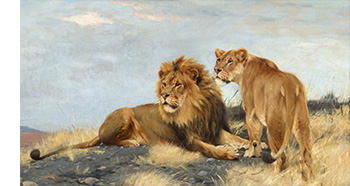
Auction
Saturday 26 October, 11 am
Kunsthaus Lempertz
Poststr. 21-22
10178 Berlin
Preview
__________________________
Monday, October 7, VERNISSAGE 6 pm
Tuesday October 8, 10 am - 5:30 pm
Wednesday October 9, 10 am - 5:30 pm
Thursday October 10, 10 am - 5:30 pm
Friday October 11, 10 am - 5.30 pm
Saturday October 12, 10 am - 4 pm
BERLIN
__________________________
Sunday October 20, VERNISSAGE 11 am - 5 pm
Monday October 21, 10 am - 5 pm
Tuesday October 22,
10 am - 5 pm & AFTER WORK PREVIEW 5 - 8 pm
Wednesday October 23, 10 a.m. - 5 pm
Thursday October 24, 10 am - 5 pm
Friday October 25, by appointment only

